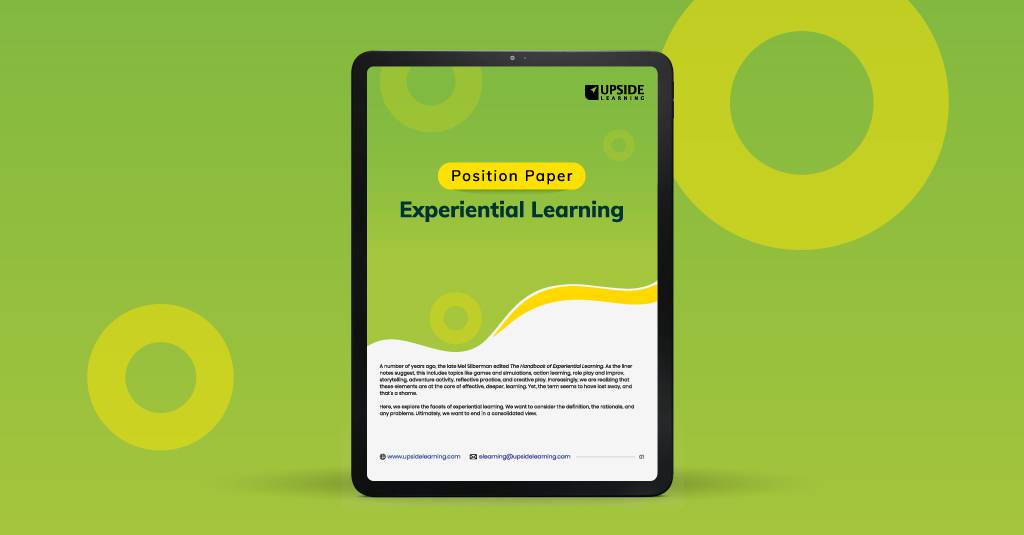As learning designers, we spend a lot of time ruminating about and discussing learning effectiveness. I think we may be a little off the mark there. Bear with me – I know how preposterous that sounds.
While learning effectiveness still has a part to play in education, when we talk about workplace learning, it helps to focus on what we’re really designing for – learning transfer.
We don’t need people to merely learn better, we mainly need them to carry out their responsibilities with more efficiency and accuracy. To achieve that, they need to transfer what they have learned into (as Clark Quinn most eloquently puts it) “all appropriate and no inappropriate situations” in the course of their work.
I’m using this lens of learning transfer to explore some design fallacies that are distracting us from optimizing for better workplace performance.
Fallacy #1 – The transfer of learning is considered complete only when learners can recall the information provided in the learning intervention after the said training.
Wouldn’t it be a perfect world if we could avert workplace accidents just by getting all our employees to “recall” safety guidelines (and sing them to the tune of Twinkle Twinkle Little Star)?
That has never worked, right?
The transfer of learning, therefore, is complete only when learners have in some way demonstrated their ability and willingness to follow precautionary safety procedures and perform/trigger emergency protocol in case a safety incident occurs. In other words, such behavior has to become their second nature for the transfer of learning to be considered complete.
So essentially, since workplace learning is not for the sake of learning itself, the outcomes need to be measured against performance parameters and not knowledge parameters.
Fallacy #2 – All content should be created equal.
Once the goalpost moves from knowledge to performance, the lens with which we approach content needs to change too. Since workplace learning is aligned with performance outcomes, we need to wear the Performance Consultant hat instead of the Learning Consultant one – and a Performance Consultant’s aim is to enable learners to perform their jobs better.
We need to be able to segregate content into:
- Knowledge in the head – information that is vital to workplace performance, and needs to be retrievable from memory whenever and as many times as required; and
- Knowledge in the world – information that supports workplace performance and is fed as “cues” into the workplace environment so it can be readily referenced as and when required.
For instance, if the objective is for a set of learners to be able to use a new system, you need to segregate the system’s functions into:
- Actions that are integral to the work the audience does – The solution must be designed with the objective of enabling learners to perform these actions with various levels of automaticity in the real world. In other words, this is information they need to learn and retain in their memory.
- Actions that are “good-to-know” and/or may need to be performed as an exception – Considering that each of us only has finite storage space in our working memory, we can reduce cognitive load for learners by embedding this information in their work environment for easy access. The solution must therefore be designed with the objective of allowing learners to refer to this material with minimum effort when they need it, and in a form that allows them to perform the action “in the flow of work”.
Fallacy #3 – Excessive content and done-to-death page-turners.
For too long we’ve burdened learners with tons of content, and then added token knowledge checks that test recall. The result has been consistent – 80% assessment scores, but little measurable improvement in performance.
It’s time to turn this model on its head. If learners are expected to perform certain actions in the real world, we need to prime them to do exactly that – and allow them to fail in a safe space with no real-world consequences, over and over again, till they gain confidence and do it right.
Consider a parent teaching a child how to ride a bicycle. No number of theoretical sessions about the workings of a bicycle and the science of balance will enable that child to ride the bicycle. However, taking them out on a bike ride with training wheels on, can help them practice the skill of building balance in a safe space. And what’s more, falling a few times in a grassy field rather than a crowded street will help them understand and bear the consequences of mistakes in an environment that protects them from serious injury.
That’s exactly what we should be able to simulate in our learning programs – safe practice opportunities that incrementally build confidence and competency in the tasks tied to the performance outcomes.
And it’s only after we design these practice experiences that we plug in content.
But when we’re being so moderate and cautious with the amount of content we add, it puts that much more onus on us to ensure that it really counts!
What do learners really need in the form of content? The bare minimum…
- Causal explanations for why they’re supposed to do things a certain way, or in other words, mental models. It can be difficult to mug up a set of process steps, but once you understand the logic that drives the sequence for those steps, you’re much more likely to remember the process.
- Worked examples are another great way to cover varied contexts in which the content can be applied. This works especially well with novice learners. While we’re waking up to the importance of scenarios in learning, worked examples still remain a grossly underused instructional strategy. Narrative-driven examples that lay out a problem statement, the context in which it occurred, the application of a mental model to arrive at a solution, and the misconceptions that can imperil the desired outcome, are far more useful to learners than abstract concepts chunked into pages and pages of eLearning courses.
Arguably, those two forms of content are all learners need, apart from insightful and consequential feedback embedded into practice exercises.
To conclude, I’d just like to reiterate that, unlike students, workplace learners are neither required nor expected to “learn” – they’re expected to “perform”. For the longest time, learning designers have been made to mimic strategies used in education. Unlearning is never easy, but we need to start somewhere. Let’s start simply by asking ourselves at every step of the design phase – “Does this enable my audience to perform their jobs better?”














